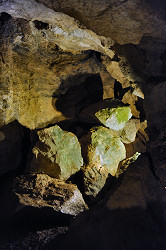Incasion Caves
Breakdown Caves
Incasion Caves are caves formed mainly by the collapse of the roof.
This process does not create caves but may transform them substantially.
Synonyms: cave breakdown, downfall, collapse, roof fall, rock fall, roof stoping, cavity migration, cave-in

Incasion or Breakdown is a speleological term which means all kinds of collapse related processes as a matter of cave formation or cave development. In most cases this means rock falling from the ceiling of a cave and forming heaps of debris at the floor. In active caves, caves with a river running through, the debris is continually moved out of the cave by the cave river. In fossil caves, caves without a river running through, the debris forms a heap on the floor of the cave. While the ceiling moves up by loosing rocks, the floor also moves upwards by being covered with the debris, and after some time the original cave is completely filled with debris. The cave is slowly moving upward, until it is a completely new cave above the old one.
Breakdown is a mechanical process and not restricted on soluble rocks like karstification. This process happens with any kind of underground void, both natural and artificial. In natural caves it is an important factor of cave formations, but it is also a process which forms caves in unsuitable rock. A widespread and important example is underground mining. Abandoned mines, if not refilled, tend to create even faster Breakdown processes than natural caves. So there might be a cave passage now, above an original mine tunnel which is completely filled in. It is still discussed if this might be called a cave, or in other words if the result of this natural process is a natural cave. Of course, it could not have been formed without the existence of the mine, which was artificial.
 Search DuckDuckGo for "Breakdown cave"
Search DuckDuckGo for "Breakdown cave" Incasion, Breakdown, chapter of Karst Hydrology and Physical Speleology by Alfred Bögli. (visited: 31-OCT-2024)
Incasion, Breakdown, chapter of Karst Hydrology and Physical Speleology by Alfred Bögli. (visited: 31-OCT-2024)
 Index
Index Topics
Topics Hierarchical
Hierarchical Countries
Countries Maps
Maps